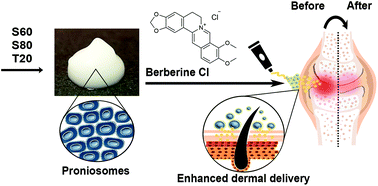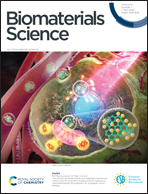Enhanced skin penetration of berberine from proniosome gel attenuates pain and inflammation in a mouse model of osteoarthritis†
Abstract
Dermal delivery of bioactive molecules remains an attractive route of administration in osteoarthritis (OA) due to the local accumulation of drugs while avoiding their systemic side effects. In this study we propose a proniosome gel comprising non-ionic surfactants that self-assemble into de-hydrated vesicles for the delivery of the natural anti-inflammatory compound berberine. By modulating the hydrating ability of the proniosome gel, berberine can be efficiently released with minimal mechanical force. A combination of sorbitan oleate (S80) and polyethlene glycol sorbitan monolaurate (T20) in a sorbitan stearate (S60)-based proniosome enables a readily hydrated gel to deliver berberine into the skin, as confirmed by ex vivo skin permeation studies. Concurrently, an in vitro model of OA using primary mouse chondrocytes demonstrated that the release of berberine at a concentration as low as 1 μg mL−1 is sufficient to restore the production of sulphated glycosaminoglycans (sGAG) to levels comparable to healthy chondrocytes while avoiding the cytotoxic concentrations (IC50 = 33 μg mL−1) on skin keratinocytes. In a mouse model of OA, the optimized formulation is able to attenuate inflammation and pain and minimize cartilage degeneration. Taken together, these data demonstrate the feasibility of adopting proniosome gels as a suitable platform to deliver active molecules for the management of osteoarthritis.



 Please wait while we load your content...
Please wait while we load your content...